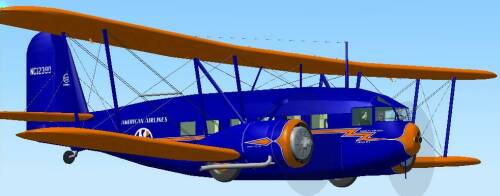

The Condor was a biplane airliner that entered service at the same time as the Boeing 247 and the Douglas DC-2. It was technically excellent, and had such modern features as an electrically-operated, retractable undercarriage, but it was unable to compete with the new, all-metal monoplanes.
Curtiss built 45 Condors. The first 21 were of the original T-32 version with fixed pitch propellers. The AT-32 was an improved version with supercharged engines, variable-pitch propellers and a larger payload. The BT-32 and CT-32 were military versions for China, Colombia, Peru and Argentina. The T-32 entered service with American Airways (later renamed American Airlines) and Eastern Air Transport in 1933. With American, the Condors were employed on the southern trans-continental coast-to-coast service (New York-Washington-Memphis-Dallas-Ft. Worth-El Paso-Tucson-Phoenix-Los Angeles). Eastern used the Condors on the route from New York to Miami.
Within a few years, however, the Condors were replaced by DC-2s and DC-3s and were no longer used on the main routes. The improved AT-32 was mainly used by American Airlines, which ordered 10 and had most of its original T-32’s converted to a similar standard. The AT-32’s were built with different engine versions and seating arrangements, the AT-32A had Wright SGR-1820-F3 Cyclone engines and carried 12 passengers in a convertible day/night layout. (Description courtesy of Jens Kristensen.)
 FS2004/FSX American Airlines
AT-32 Condor. Jens Kristensen has created a beautiful model of the Curtiss
Condor II, last of the US biplane propliners. American flew it because the 247
and DC-2 did not have enough fuselage width to accommodate berths. After CR
Smith convinced Douglas to build the DC-3, the slow Condor couldn't compete.
Last updated on 2/15/07.
FS2004/FSX American Airlines
AT-32 Condor. Jens Kristensen has created a beautiful model of the Curtiss
Condor II, last of the US biplane propliners. American flew it because the 247
and DC-2 did not have enough fuselage width to accommodate berths. After CR
Smith convinced Douglas to build the DC-3, the slow Condor couldn't compete.
Last updated on 2/15/07.